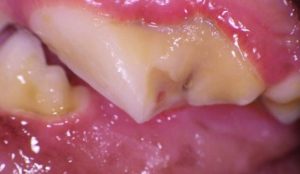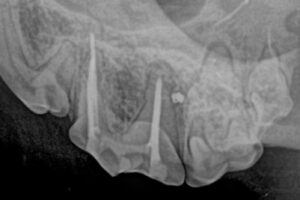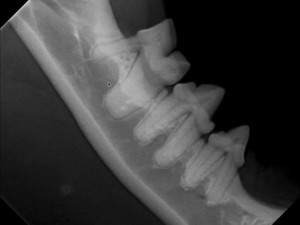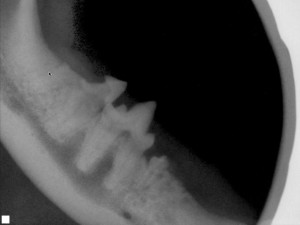Dental procedures performed at BWVC:
Extractions
(Periodontal disease, fractured teeth, feline chronic gingivostomatitis, contact mucositis)
Removal of impacted teeth and dentigerous cysts
Retained deciduous tooth extractions
Malocclusion treatment planning
Root Canal Therapy
Vital Pulp Therapy
Crown Reduction
Restorations (enamel defects and cavity preps)
Advanced periodontal surgery & guided tissue regeneration
Root Retrieval
Biopsies
Mandibulectomy
Rostral Maxillectomy
Fracture repair
Early Gum Disease is Reversible!
Pets build up plaque and tartar on their teeth just like people! At Bayview Wellington, we perform more than just a dental cleaning. Dentistry includes a complete oral exam, assessment of each individual tooth, and oral x-rays. Most oral disease occurs below the gum surface. Many small dogs have periodontal disease before the age of 18 months and cats and large dogs often have it by the age of five! Untreated dental problems lead to pain, infection, bad breath, broken teeth and overall poor health.
What is a COHAT?
COMPLETE ORAL HEALTH CARE
During a comprehensive oral health assessment and treatment (COHAT), your pet’s whole mouth will be assessed. Radiographs and photographs are taken of all of the teeth. Close attention is paid to each tooth. Gross tartar and calculus is removed using an ultrasonic scaler and gentle sub-gingival cleaning is performed. Careful probing around each tooth defines areas of gingival attachment loss. The doctor will call you to discuss the findings and treatment can be performed with your consent. Healthy teeth are polished using an air driven hand piece and powder.
Keeping Your Pet Comfortable
Our caring veterinarians and team members want your pet to have a pleasant experience while at our clinic. We are dedicated to keeping your pet safe and well cared for on the day of dentistry. We want to alleviate your stress with the comfort of knowing your pet will be kept pain free, safe and warm on the day of dentistry.
Pre-Surgical Blood Work
Blood work is important prior to dentistry in order to optimize the safety of your pet and address any concurrent issues.
IV Fluids
All pets undergoing anaesthesia need IV fluid therapy! This is a crucial safety measure. It is needed to maintain blood pressure and adequate circulation. It also enables us to give drugs quickly and directly into the bloodstream.
Temperature Control
During the procedure, we actively warm your pet with a heating blanket that blows hot air onto your pet’s body. Without adequate warming, your pet’s body temperature will drop. Maintaining a normal body temperature is an important safety measure.
Advanced Monitoring
The anaesthetist, a Registered Veterinary Technician highly trained in anaesthetic delivery and monitoring is always at your pet’s side. She will be monitoring your pet’s blood pressure, oxygen level, carbon dioxide level, pulse, pulse pressure, respiratory rate and depth of anaesthetic. To ensure the anaesthetic is as safe as possible, these levels must be monitored and maintained at all times.
Radiographs
Intraoral radiographs are essential to visualize disease below the gum surface.
Canine Radiographs
Feline Radiographs
Tooth Assessment and Cleaning
Your pet’s whole mouth will be assessed. Close attention is paid to each tooth. Gross tartar and calculus is removed using an ultrasonic scaler and gentle sub-gingival cleaning is performed. Careful probing around each tooth defines areas of gingival attachment loss. Healthy teeth are polished using an air driven low-speed hand piece and polish paste.
We treat dental problems every day. Here are a few common issues:
Persistent deciduous (baby) teeth: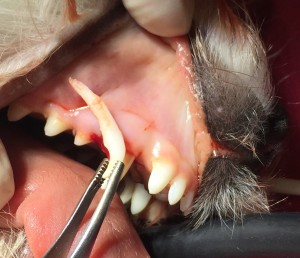
Puppies and kittens should lose their baby teeth between 4 and 6 months of age. When they do not fall out naturally they must be extracted. Notice how long the roots are. These must be removed entirely. Radiographs should be performed before and after removal to confirm complete removal.
Fractured Teeth:
Fractured teeth cause pain and will lead to infections. Treatment is based on the severity and type of fracture. Treatment options are often extraction or root canal therapy.
Periodontal disease: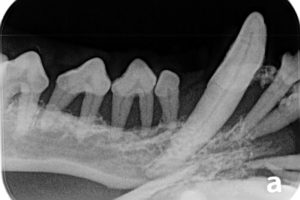
Bacteria works its way under the gum and causes an inflammatory reaction. Left untreated, this will progress to attachment loss and destruction of the bone supporting the teeth. This is a silently painful process. Your pet will not tell you that there is a problem. Sometimes you will notice bad breath. Bad breath is never normal!
Tooth Resorption:
Commonly, dogs and cats will start to destroy / resorb their own teeth. This is a very painful process once it approaches the crown of the tooth. The first radiograph is of the three relatively normal lower teeth in a cat and the second xray is of tooth resorption.
Missing teeth:
Teeth that appear to be missing may not truly be missing! They may be impacted below the gum line :
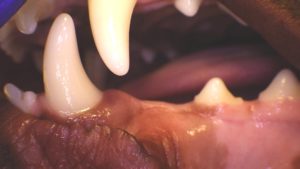
Or the crown may have fractured off, leaving the roots to be a constant source of pain and infection:
Home care is crucial for your pet’s oral health!
- Dental Care for Cats
- Dental Care Guidelines set by the American Animal Hospital Association
- Dental Disease — The most common disease in dogs and cats!
- Approved products for oral care!


